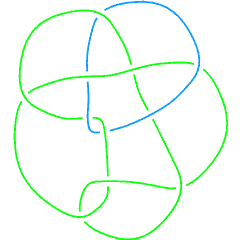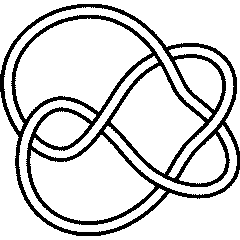Identifying Knots within a List: Difference between revisions
No edit summary |
No edit summary |
||
| Line 1: | Line 1: | ||
{{Manual TOC Sidebar}} |
{{Manual TOC Sidebar}} |
||
<code>IdentifyWithin[L,H]</code> returns those elements from the list of knots <math>H</math>, whose invariant matches that of the knot <math>L</math>. It can also recognize mirrors and connected sums of the knots in the list. Its options include turning off (on) the search for connected sums with <code>ConnectedSum->False (True)</code> and choosing the invariants to be used in identification by selecting, for example, <code>Invariants->{Jones[#][q]&, HOMFLYPT[#][a,z]&}</code>. |
<code>IdentifyWithin[L,H]</code>, whose code is available [[IdentifyWithin.m|here]], returns those elements from the list of knots <math>H</math>, whose invariant matches that of the knot <math>L</math>. It can also recognize mirrors and connected sums of the knots in the list. Its options include turning off (on) the search for connected sums with <code>ConnectedSum->False (True)</code> and choosing the invariants to be used in identification by selecting, for example, <code>Invariants->{Jones[#][q]&, HOMFLYPT[#][a,z]&}</code>. |
||
<code>IdentifyWithin</code> can be used together with [[Prime Links with a Non-Prime Component|<code>SubLink</code>]] to determine the components of a link. For the second component of link [[L11n150]], for instance, we get: |
<code>IdentifyWithin</code> can be used together with [[Prime Links with a Non-Prime Component|<code>SubLink</code>]] to determine the components of a link. For the second component of link [[L11n150]], for instance, we get: |
||
{{Startup Note}} |
{{Startup Note}} |
||
<!--$$ |
<!--$$Import["http://katlas.org/wiki/IdentifyWithin.m&action=raw"];$$--><!--END--> |
||
Invariants -> {Jones[#][q] &, HOMFLYPT[#][a, z] &, |
|||
Kauffman[#][a, z] &}, |
|||
ConnectedSum -> "True"}; |
|||
IdentifyWithin[L_, H_List, opts___Rule] := |
|||
Module[ |
|||
{div, j = 1, l, i = 1, u, mu, t, mt, out = {}, out1 = {}, nk, mnk, |
|||
mnk1, p, mp, m, p1, |
|||
invariants = (Invariants /. {opts} /. Options[IdentifyWithin]), |
|||
connectedsum = (ConnectedSum /. {opts} /. |
|||
Options[IdentifyWithin])}, |
|||
NormalizeP[poly_] := Module[{t1, i1}, |
|||
(For[i1 = 1 ; t1 := FactorList[poly], |
|||
i1 <= Length[Variables[poly]], i1++, |
|||
t1 = |
|||
DeleteCases[t1, {Variables[poly][[i1]], _Integer} | {1, 1}]]; |
|||
Times @@ Power @@@ t1 )]; |
|||
l := Length[invariants]; |
|||
u[0] = mu[0] = H; |
|||
While[i <= l && ! Length[out] === 1, |
|||
t[i] = invariants[[i]][L]; |
|||
mt[i] = invariants[[i]][Mirror[L]]; |
|||
u[i] = Select[u[i - 1], t[i] == invariants[[i]][#] &]; |
|||
mu[i] = Select[mu[i - 1], mt[i] == invariants[[i]][#] &]; |
|||
out = Flatten[{u[i], Mirror /@ mu[i]}]; |
|||
i++]; |
|||
Which[ |
|||
Length[out] >= 2, DeleteCases[out, Mirror[Knot[0, 1]]], |
|||
Length[out] == 1, |
|||
out = If[u[i - 1] != {}, u[i - 1], Mirror /@ mu[i - 1]], |
|||
connectedsum === "True", i = 1; nk[0] = mnk[0] = H; |
|||
While[Length[out1] != 1 && i <= l, |
|||
p[i] = NormalizeP[t[i]]; |
|||
mp[i] = NormalizeP[mt[i]]; |
|||
nk[i] = |
|||
Select[nk[i - 1], (p1 = NormalizeP[invariants[[i]][#]]; z = 3; |
|||
PolynomialRemainder[p[i], p1, Variables[p[i]][[1]]] === |
|||
0 ) &]; |
|||
mnk[i] = |
|||
Select[mnk[i - 1], (p1 = NormalizeP[invariants[[i]][#]]; z = 3; |
|||
PolynomialRemainder[mp[i], p1, Variables[p[i]][[1]]] === |
|||
0 ) &]; |
|||
Clear[z]; |
|||
mnk1[i] = Mirror /@ mnk[i]; |
|||
div = Flatten[{nk[i], mnk1[i]}]; |
|||
div = DeleteCases[div, Knot[0, 1] | Mirror[Knot[0, 1]]]; |
|||
If[div == {}, out1 = {}, |
|||
For[m = 1; |
|||
W[0] = |
|||
CS[0] = Select[ |
|||
Flatten /@ Flatten[Outer[List, div, div, 1], 1], OrderedQ], |
|||
Length[W[m - 1][[1]]] < 4, m++, |
|||
W[m] = Select[ |
|||
Flatten /@ Flatten[Outer[List, div, W[m - 1], 1], 1], |
|||
OrderedQ]; |
|||
CS[m] = Flatten[{CS[m - 1], W[m]}, 1]; |
|||
]; |
|||
out1 = |
|||
Select[CS[m - 1], |
|||
Expand[Times @@ invariants[[i]] /@ #] == t[i] &]; |
|||
]; |
|||
i++]; |
|||
If[out1 == {}, {}, ConnectedSum @@@ out1], True, {} |
|||
] |
|||
];$$--> |
|||
<!--Robot Land, no human edits to "END"--> |
|||
{{In| |
|||
n = 3 | |
|||
in = <nowiki>Options[IdentifyWithin] = { |
|||
Invariants -> {Jones[#][q] &, HOMFLYPT[#][a, z] &, |
|||
Kauffman[#][a, z] &}, |
|||
ConnectedSum -> "True"}; |
|||
IdentifyWithin[L_, H_List, opts___Rule] := |
|||
Module[ |
|||
{div, j = 1, l, i = 1, u, mu, t, mt, out = {}, out1 = {}, nk, mnk, |
|||
mnk1, p, mp, m, p1, |
|||
invariants = (Invariants /. {opts} /. Options[IdentifyWithin]), |
|||
connectedsum = (ConnectedSum /. {opts} /. |
|||
Options[IdentifyWithin])}, |
|||
NormalizeP[poly_] := Module[{t1, i1}, |
|||
(For[i1 = 1 ; t1 := FactorList[poly], |
|||
i1 <= Length[Variables[poly]], i1++, |
|||
t1 = |
|||
DeleteCases[t1, {Variables[poly][[i1]], _Integer} | {1, 1}]]; |
|||
Times @@ Power @@@ t1 )]; |
|||
l := Length[invariants]; |
|||
u[0] = mu[0] = H; |
|||
While[i <= l && ! Length[out] === 1, |
|||
t[i] = invariants[[i]][L]; |
|||
mt[i] = invariants[[i]][Mirror[L]]; |
|||
u[i] = Select[u[i - 1], t[i] == invariants[[i]][#] &]; |
|||
mu[i] = Select[mu[i - 1], mt[i] == invariants[[i]][#] &]; |
|||
out = Flatten[{u[i], Mirror /@ mu[i]}]; |
|||
i++]; |
|||
Which[ |
|||
Length[out] >= 2, DeleteCases[out, Mirror[Knot[0, 1]]], |
|||
Length[out] == 1, |
|||
out = If[u[i - 1] != {}, u[i - 1], Mirror /@ mu[i - 1]], |
|||
connectedsum === "True", i = 1; nk[0] = mnk[0] = H; |
|||
While[Length[out1] != 1 && i <= l, |
|||
p[i] = NormalizeP[t[i]]; |
|||
mp[i] = NormalizeP[mt[i]]; |
|||
nk[i] = |
|||
Select[nk[i - 1], (p1 = NormalizeP[invariants[[i]][#]]; z = 3; |
|||
PolynomialRemainder[p[i], p1, Variables[p[i]][[1]]] === |
|||
0 ) &]; |
|||
mnk[i] = |
|||
Select[mnk[i - 1], (p1 = NormalizeP[invariants[[i]][#]]; z = 3; |
|||
PolynomialRemainder[mp[i], p1, Variables[p[i]][[1]]] === |
|||
0 ) &]; |
|||
Clear[z]; |
|||
mnk1[i] = Mirror /@ mnk[i]; |
|||
div = Flatten[{nk[i], mnk1[i]}]; |
|||
div = DeleteCases[div, Knot[0, 1] | Mirror[Knot[0, 1]]]; |
|||
If[div == {}, out1 = {}, |
|||
For[m = 1; |
|||
W[0] = |
|||
CS[0] = Select[ |
|||
Flatten /@ Flatten[Outer[List, div, div, 1], 1], OrderedQ], |
|||
Length[W[m - 1][[1]]] < 4, m++, |
|||
W[m] = Select[ |
|||
Flatten /@ Flatten[Outer[List, div, W[m - 1], 1], 1], |
|||
OrderedQ]; |
|||
CS[m] = Flatten[{CS[m - 1], W[m]}, 1]; |
|||
]; |
|||
out1 = |
|||
Select[CS[m - 1], |
|||
Expand[Times @@ invariants[[i]] /@ #] == t[i] &]; |
|||
]; |
|||
i++]; |
|||
If[out1 == {}, {}, ConnectedSum @@@ out1], True, {} |
|||
] |
|||
];</nowiki>}} |
|||
<!--END--> |
|||
<!--$$SubLink[pd_PD, js_List] := Module[ |
<!--$$SubLink[pd_PD, js_List] := Module[ |
||
Revision as of 20:38, 18 November 2007
IdentifyWithin[L,H], whose code is available here, returns those elements from the list of knots , whose invariant matches that of the knot . It can also recognize mirrors and connected sums of the knots in the list. Its options include turning off (on) the search for connected sums with ConnectedSum->False (True) and choosing the invariants to be used in identification by selecting, for example, Invariants->{Jones[#][q]&, HOMFLYPT[#][a,z]&}.
IdentifyWithin can be used together with SubLink to determine the components of a link. For the second component of link L11n150, for instance, we get:
(For In[1] see Setup)
In[2]:=
|
IdentifyWithin[SubLink[Link["L11n150"], 2], AllKnots[]]
|
Out[2]=
|
{Knot[5, 2]}
|
 L11n150 |
 5_2 |
Unfortunately, the program does not provide absolute identification when all the used invariants cannot distinguish between two or more different knots. In that case, a list of possible candidates for is returned.

